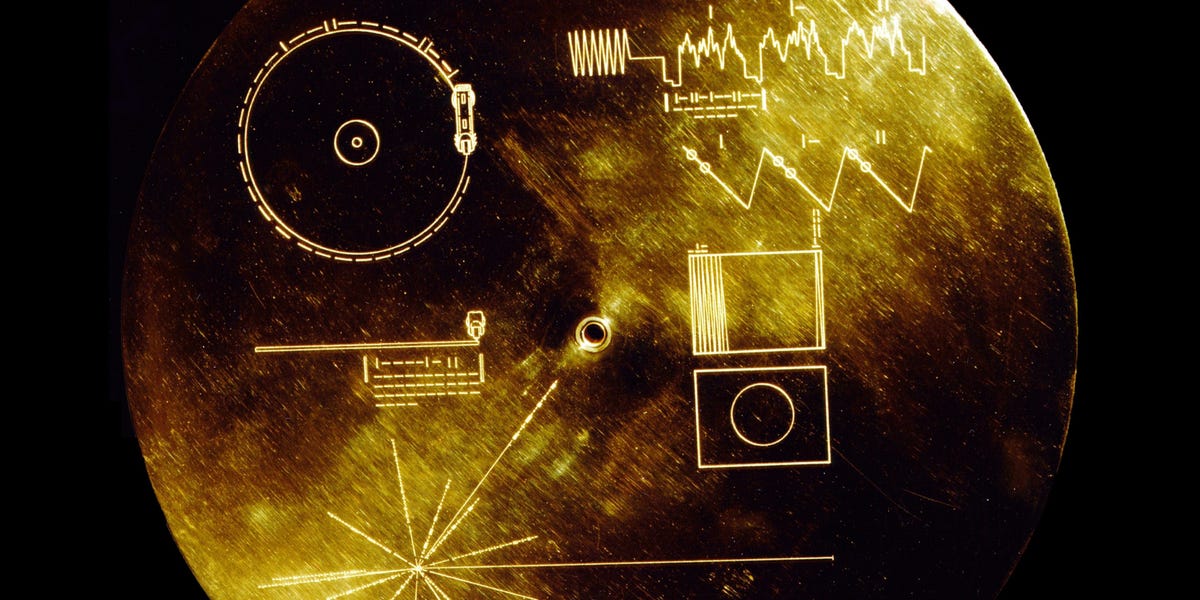The Tesla and SpaceX CEO commented on a post on X (formerly Twitter) on Wednesday that included an image of a golden record.
“I have one,” Musk said in the post.
Musk wasn’t clear on whether he had an original or a copy, and he didn’t respond to a request for comment.
But his post had me wondering: Who has the original golden records?
Tracking down the golden records
NASA launched two golden records into space on Voyager 1 and Voyager 2 in 1977 as a way to teach other civilizations about life on Earth if they ever came across the probes.
The twin spacecraft were launched over 40 years ago to explore the outer solar system.
The golden records attached to the exterior of the spacecrafts, with visual instructions on how to play 115 images, spoken greetings in 55 languages, and variation of sounds from Earth, including a 90-minute music playlist, according to a post on NASA’s Jet Propulsion Laboratory (JPL).
The 12-inch gold-plated copper disks also include a message from President Carter and U.N. Secretary-General Waldheim, according to NASA.
When I started looking into the golden records, I noticed conflicting numbers for how many originals were created. Some news articles cited 10 golden records, others said there were eight total.
But according to an archivist at JPL, there were 12 original records: two of them went to space and 10 were given to institutions or people on Earth.
Here are the institutions and people who got a copy, according to the JPL archivist:
-
NASA’s Jet Propulsion Laboratory
-
Johnson Space Center
-
Kennedy Space Center
-
Glenn Research Center
-
Langley Research Center
-
Goddard Space Flight Center
-
National Air & Space Museum at the Smithsonian
-
The Library of Congress
-
The President
-
The United Nations
But only eight of the 10 on Earth are currently accounted for. According to the archivist, the copies that went to Langley Research Center and President Carter couldn’t be located a few years ago.
While Musk probably doesn’t have an original golden record, he could have a copy. There was a successful Kickstarter to fund a box set of the record and they’re now sold online starting at $88.
But the original materials are for sale — and Jon Lomberg, the design director of the golden record, has all of the original images and other archival material from the golden record.
He told BI he’d be happy to sell it to Musk.
“There’s a way that you can feel, I think, a personal attachment to that project by knowing that this was the actual slide that the people that made the record used and looked at and argued over and decided to scan and send into space and it,” Lomberg said.
A personal copy of the master audio recording owned by the late Carl Sagan, the lead scientist of the project, went to auction at Sotheby’s in July 2023, but didn’t hit its reserve and wasn’t sold.
And it should be noted: not even Sagan himself got a copy of the original record.
Voyager 1 and 2’s ongoing mission
Since launching, the spacecraft discovered volcanoes on Jupiter’s moon, identified the intricacies of Saturn’s rings, and took the first close-up photographs of Uranus and Neptune.
NASA has since extended the mission and has kept in communication with the probes as they enter interstellar space.
Their current mission is to explore the outermost edge of the Sun’s domain.
Voyager 1 is about 15 billion miles from Earth, and Voyager 2 is a little over 12.5 billion miles away, according to tracking information from JPL.
Since December, Voyager 1 has had issues with its flight data system, keeping Earth from receiving any data. JPL spokesperson Calla Cofield told BI that NASA doesn’t have any updates on Voyager 1.
“The team continues information gathering and are preparing some steps that they’re hopeful will get them on a path to either understanding the root of the problem and/or solving it,” Cofield said.
Voyager 2 is operating normally after brief communication issues last year, according to a NASA update posted in August.
While the golden records on the Voyager spacecraft are expected to last over a billion years, Lomberg said the probes will probably crash on another planet or star eventually.
Lomberg said that, in some sense, the golden records sent to space are dated by now: they don’t have any information on personal computers or rap music.
But he said the message is still timeless.
“The fundamental things that we show, the mountains and the rivers and the oceans and parents and children and the beauty of sport,” Lomberg said. “There’s some things that never age.”




